2019 Hyundai Nexo coolant
[x] Cancel search: coolantPage 500 of 560
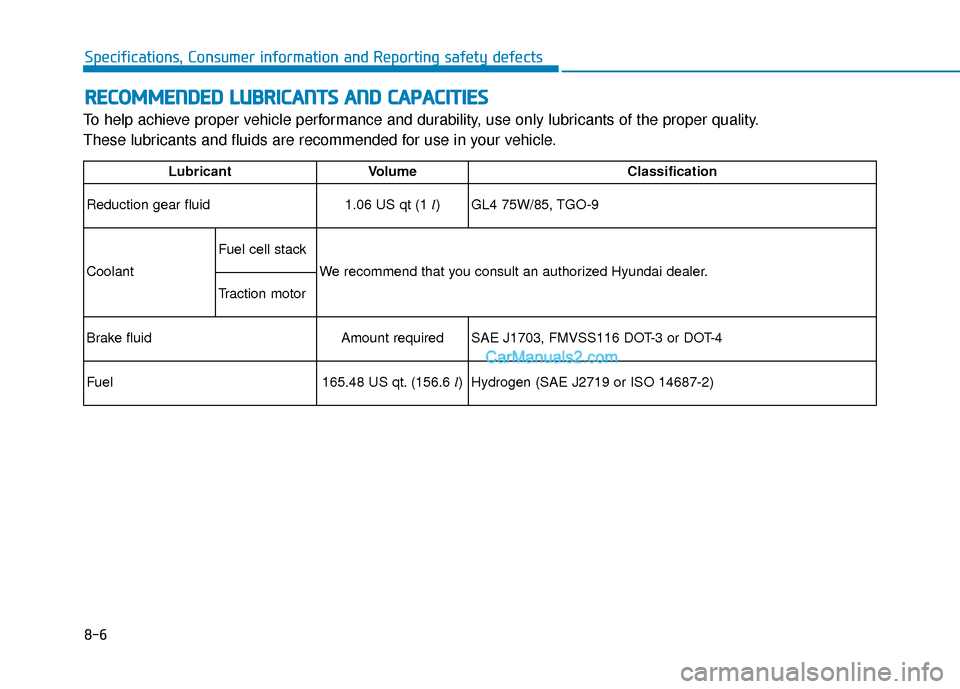
8-6
Specifications, Consumer information and Reporting safety defects
R
RE
EC
CO
O M
M M
ME
EN
N D
DE
ED
D
L
L U
U B
BR
RI
IC
C A
A N
N T
TS
S
A
A N
N D
D
C
C A
A P
PA
A C
CI
IT
T I
IE
E S
S
To help achieve proper vehicle performance and durability, use only lubricants of the proper quality.
These lubricants and fluids are recommended for use in your vehicle.
Lubricant Volume Classification
Reduction gear fluid 1.06 US qt (1 l)
GL4 75W/85, TGO-9
Coolant Fuel cell stack
We recommend that you consult an authorized Hyundai dealer.
Traction motor
Brake fluid Amount required SAE J1703, FMVSS116 DOT-3 or DOT-4
Fuel 165.48 US qt. (156.6
l)
Hydrogen (SAE J2719 or ISO 14687-2)
Page 511 of 560
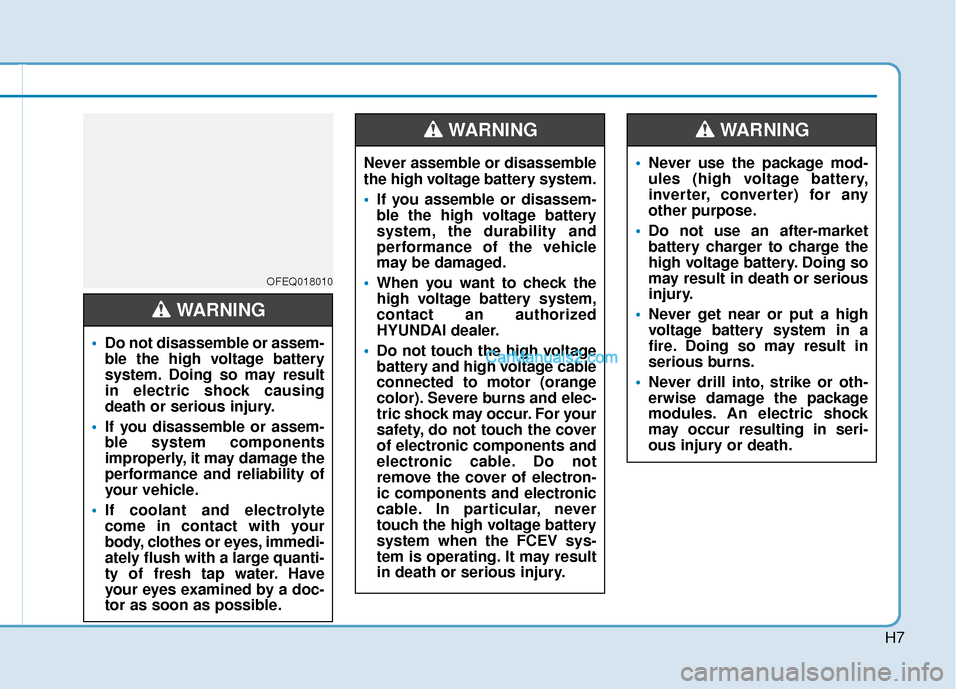
H7
OFEQ018010
•Do not disassemble or assem-
ble the high voltage battery
system. Doing so may result
in electric shock causing
death or serious injury.
If you disassemble or assem-
ble system components
improperly, it may damage the
performance and reliability of
your vehicle.
If coolant and electrolyte
come in contact with your
body, clothes or eyes, immedi-
ately flush with a large quanti-
ty of fresh tap water. Have
your eyes examined by a doc-
tor as soon as possible.
WARNING
Never assemble or disassemble
the high voltage battery system.
If you assemble or disassem-
ble the high voltage battery
system, the durability and
performance of the vehicle
may be damaged.
When you want to check the
high voltage battery system,
contact an authorized
HYUNDAI dealer.
Do not touch the high voltage
battery and high voltage cable
connected to motor (orange
color). Severe burns and elec-
tric shock may occur. For your
safety, do not touch the cover
of electronic components and
electronic cable. Do not
remove the cover of electron-
ic components and electronic
cable. In particular, never
touch the high voltage battery
system when the FCEV sys-
tem is operating. It may result
in death or serious injury.
WARNING
Never use the package mod-
ules (high voltage battery,
inverter, converter) for any
other purpose.
Do not use an after-market
battery charger to charge the
high voltage battery. Doing so
may result in death or serious
injury.
Never get near or put a high
voltage battery system in a
fire. Doing so may result in
serious burns.
Never drill into, strike or oth-
erwise damage the package
modules. An electric shock
may occur resulting in seri-
ous injury or death.
WARNING
Page 520 of 560
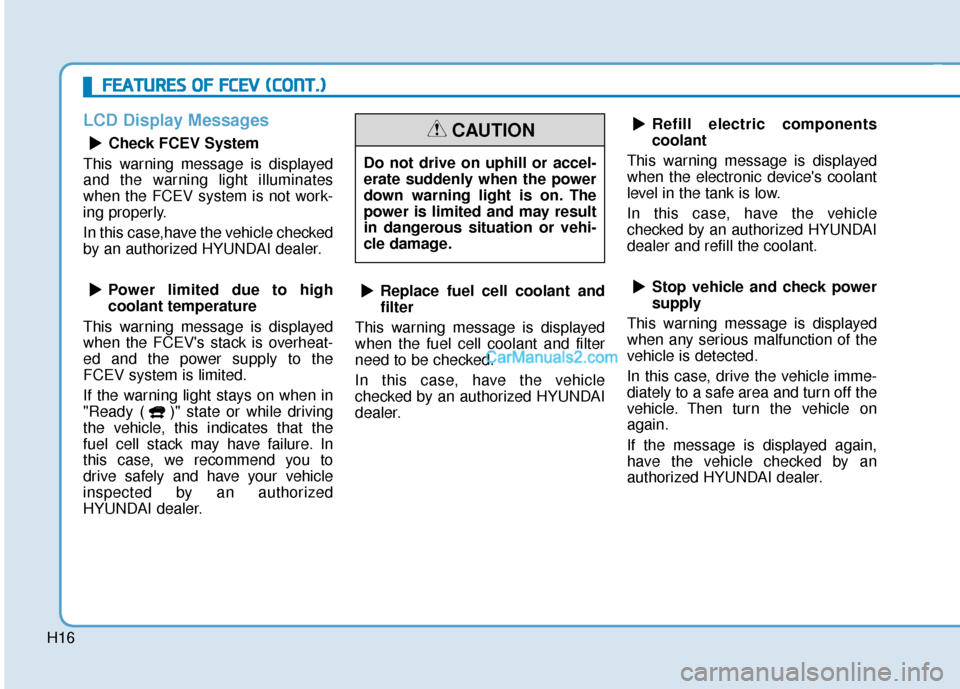
H16
F
FE
E A
A T
TU
U R
RE
ES
S
O
O F
F
F
F C
C E
E V
V
(
( C
C O
O N
NT
T.
.)
)
LCD Display Messages
Check FCEV System
This warning message is displayed
and the warning light illuminates
when the FCEV system is not work-
ing properly.
In this case,have the vehicle checked
by an authorized HYUNDAI dealer.
Power limited due to high
coolant temperature
This warning message is displayed
when the FCEV's stack is overheat-
ed and the power supply to the
FCEV system is limited.
If the warning light stays on when in
"Ready ( )" state or while driving
the vehicle, this indicates that the
fuel cell stack may have failure. In
this case, we recommend you to
drive safely and have your vehicle
inspected by an authorized
HYUNDAI dealer. Replace fuel cell coolant and
filter
This warning message is displayed
when the fuel cell coolant and filter
need to be checked.
In this case, have the vehicle
checked by an authorized HYUNDAI
dealer. Refill electric components
coolant
This warning message is displayed
when the electronic device's coolant
level in the tank is low.
In this case, have the vehicle
checked by an authorized HYUNDAI
dealer and refill the coolant.
Stop vehicle and check power
supply
This warning message is displayed
when any serious malfunction of the
vehicle is detected.
In this case, drive the vehicle imme-
diately to a safe area and turn off the
vehicle. Then turn the vehicle on
again.
If the message is displayed again,
have the vehicle checked by an
authorized HYUNDAI dealer.
▲ ▲
▲
▲
▲
▲▲
▲
▲
▲
Do not drive on uphill or accel-
erate suddenly when the power
down warning light is on. The
power is limited and may result
in dangerous situation or vehi-
cle damage.
CAUTION
Page 538 of 560
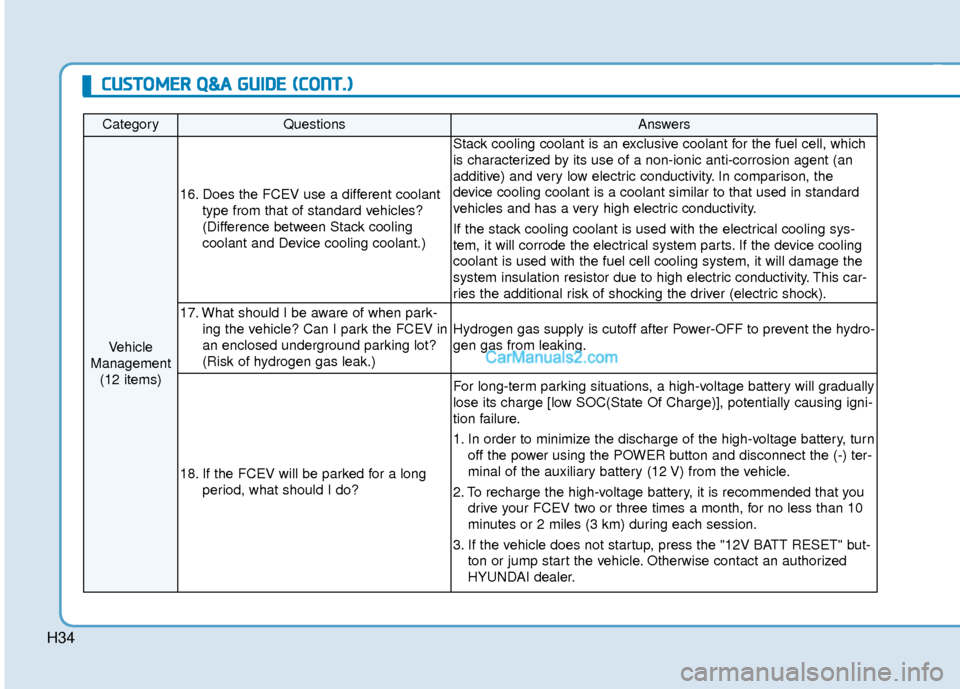
H34
CategoryQuestionsAnswers
Vehicle
Management (12 items)
16. Does the FCEV use a different coolant type from that of standard vehicles?
(Difference between Stack cooling
coolant and Device cooling coolant.)
Stack cooling coolant is an exclusive coolant for the fuel cell, which
is characterized by its use of a non-ionic anti-corrosion agent (an
additive) and very low electric conductivity. In comparison, the
device cooling coolant is a coolant similar to that used in standard
vehicles and has a very high electric conductivity.
If the stack cooling coolant is used with the electrical cooling sys-
tem, it will corrode the electrical system parts. If the device cooling
coolant is used with the fuel cell cooling system, it will damage the
system insulation resistor due to high electric conductivity. This car-
ries the additional risk of shocking the driver (electric shock).
17. What should I be aware of when park-ing the vehicle? Can I park the FCEV in
an enclosed underground parking lot?
(Risk of hydrogen gas leak.)
Hydrogen gas supply is cutoff after Power-OFF to prevent the hydro-
gen gas from leaking.
18. If the FCEV will be parked for a longperiod, what should I do?
For long-term parking situations, a high-voltage battery will gradually
lose its charge [low SOC(State Of Charge)], potentially causing igni-
tion failure.
1. In order to minimize the discharge of the high-voltage battery, turnoff the power using the POWER button and disconnect the (-) ter-
minal of the auxiliary battery (12 V) from the vehicle.
2. To recharge the high-voltage battery, it is recommended that you drive your FCEV two or three times a month, for no less than 10
minutes or 2 miles (3 km) during each session.
3. If the vehicle does not startup, press the "12V BATT RESET" but- ton or jump start the vehicle. Otherwise contact an authorized
HYUNDAI dealer.
C CU
U S
ST
T O
O M
M E
ER
R
Q
Q &
&A
A
G
G U
U I
ID
D E
E
(
( C
C O
O N
NT
T.
.)
)
Page 539 of 560
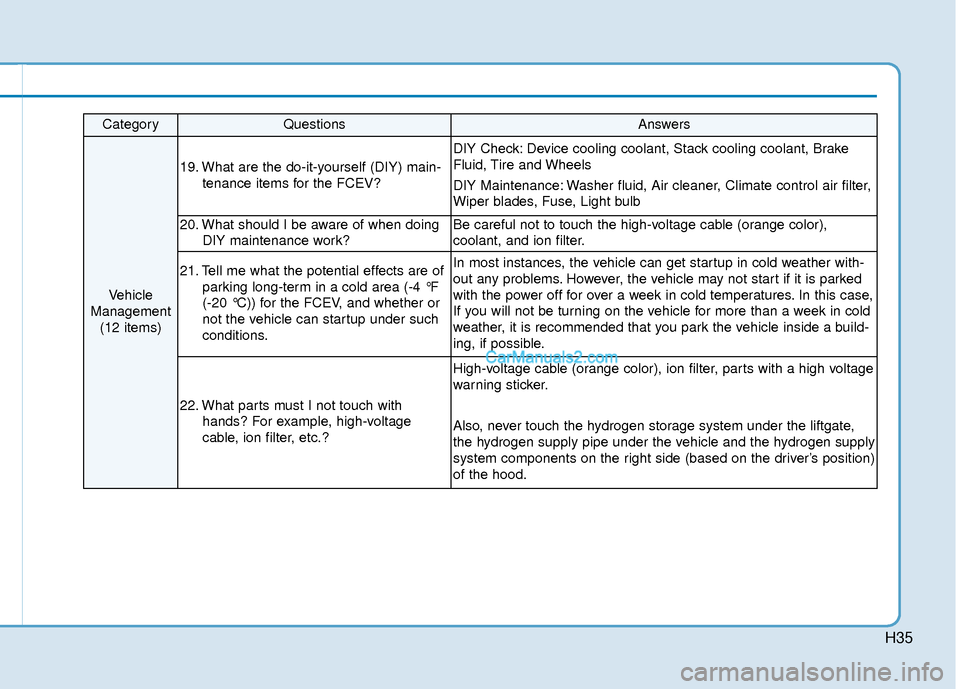
H35
CategoryQuestionsAnswers
Vehicle
Management (12 items)
19. What are the do-it-yourself (DIY) main- tenance items for the FCEV?
DIY Check: Device cooling coolant, Stack cooling coolant, Brake
Fluid, Tire and Wheels
DIY Maintenance: Washer fluid, Air cleaner, Climate control air filter,
Wiper blades, Fuse, Light bulb
20. What should I be aware of when doingDIY maintenance work?Be careful not to touch the high-voltage cable (orange color),
coolant, and ion filter.
21. Tell me what the potential effects are ofparking long-term in a cold area (-4 °F
(-20 °C)) for the FCEV, and whether or
not the vehicle can startup under such
conditions.In most instances, the vehicle can get startup in cold weather with-
out any problems. However, the vehicle may not start if it is parked
with the power off for over a week in cold temperatures. In this case,
If you will not be turning on the vehicle for more than a week in cold
weather, it is recommended that you park the vehicle inside a build-
ing, if possible.
22. What parts must I not touch withhands? For example, high-voltage
cable, ion filter, etc.?
High-voltage cable (orange color), ion filter, parts with a high voltage
warning sticker.
Also, never touch the hydrogen storage system under the liftgate,
the hydrogen supply pipe under the vehicle and the hydrogen supply
system components on the right side (based on the driver’s position)
of the hood.
Page 552 of 560
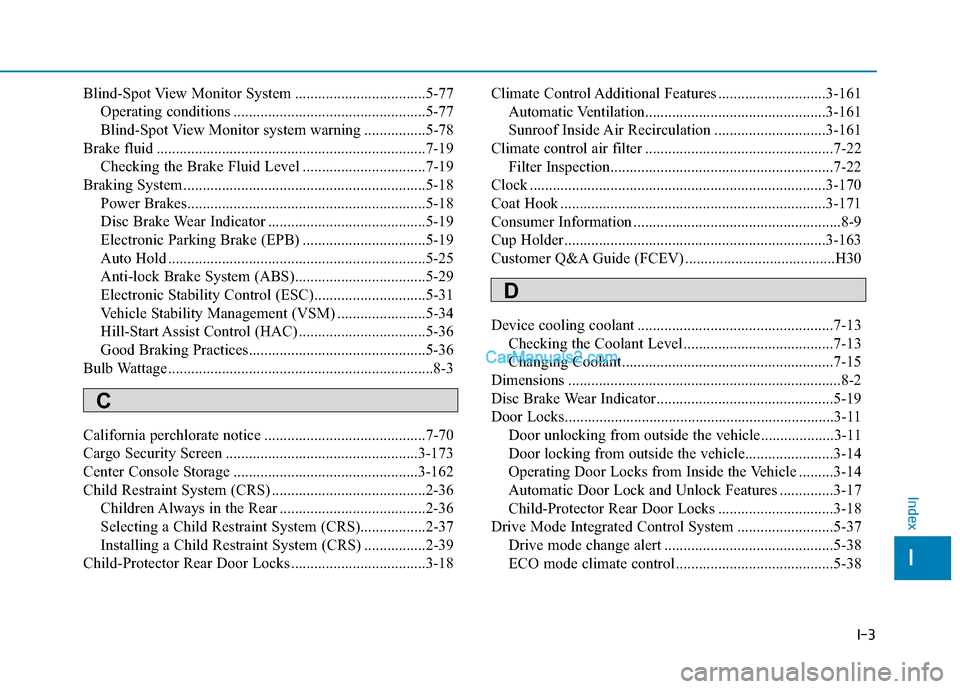
I-3
Blind-Spot View Monitor System ..................................5-77Operating conditions ..................................................5-77
Blind-Spot View Monitor system warning ................5-78
Brake fluid ......................................................................7-\
19 Checking the Brake Fluid Level ................................7-19
Braking System ...............................................................5-18 Power Brakes..............................................................5-18
Disc Brake Wear Indicator .........................................5-19
Electronic Parking Brake (EPB) ................................5-19
Auto Hold ...................................................................5-25
Anti-lock Brake System (ABS)..................................5-29
Electronic Stability Control (ESC).............................5-31
Vehicle Stability Management (VSM) .......................5-34
Hill-Start Assist Control (HAC) .................................5-36
Good Braking Practices..............................................5-36
Bulb Wattage .....................................................................8-3\
California perchlorate notice ..........................................7-70
Cargo Security Screen ..................................................3-173
Center Console Storage ................................................3-162
Child Restraint System (CRS) ........................................2-36 Children Always in the Rear ......................................2-36
Selecting a Child Restraint System (CRS).................2-37
Installing a Child Restraint System (CRS) ................2-39
Child-Protector Rear Door Locks ...................................3-18 Climate Control Additional Features ............................3-161
Automatic Ventilation...............................................3-161
Sunroof Inside Air Recirculation .............................3-161
Climate control air filter .................................................7-22 Filter Inspection..........................................................7-22
Clock ........................................................................\
.....3-170
Coat Hook .....................................................................3-1\
71
Consumer Information ......................................................8-9
Cup Holder....................................................................3-16\
3
Customer Q&A Guide (FCEV) .......................................H30
Device cooling coolant ...................................................7-13 Checking the Coolant Level .......................................7-13
Changing Coolant.......................................................7-15
Dimensions .......................................................................8\
-2
Disc Brake Wear Indicator..............................................5-19
Door Locks......................................................................3-\
11 Door unlocking from outside the vehicle...................3-11
Door locking from outside the vehicle.......................3-14
Operating Door Locks from Inside the Vehicle .........3-14
Automatic Door Lock and Unlock Features ..............3-17
Child-Protector Rear Door Locks ..............................3-18
Drive Mode Integrated Control System .........................5-37 Drive mode change alert ............................................5-38
ECO mode climate control .........................................5-38
I
Index
C
D
Page 558 of 560
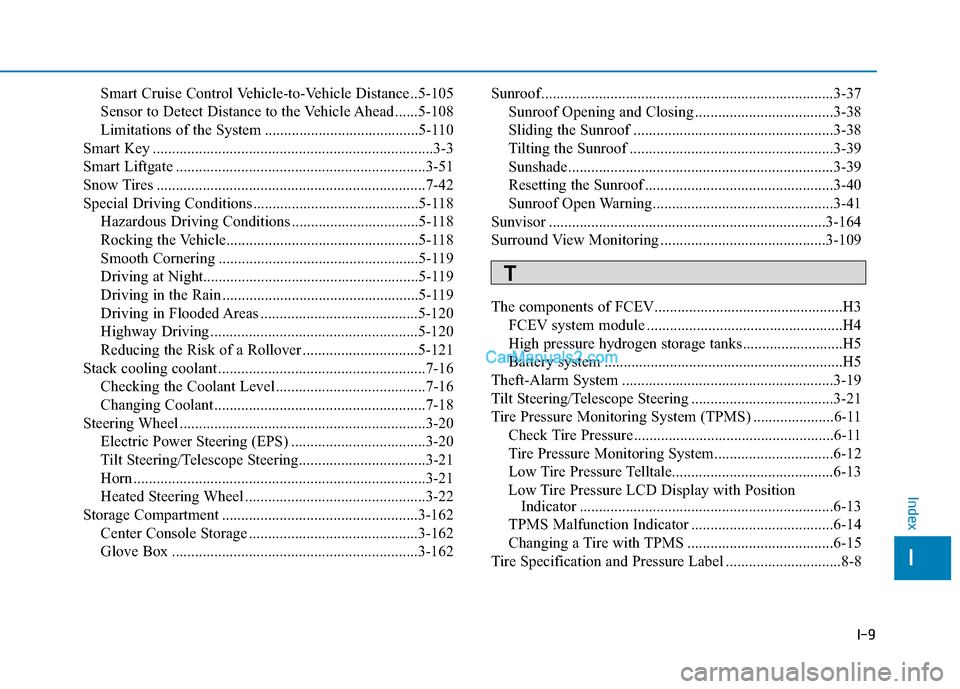
I-9
Smart Cruise Control Vehicle-to-Vehicle Distance ..5-105
Sensor to Detect Distance to the Vehicle Ahead ......5-108
Limitations of the System ........................................5-110
Smart Key ........................................................................\
.3-3
Smart Liftgate .................................................................3-51
Snow Tires ......................................................................7-\
42
Special Driving Conditions ...........................................5-118 Hazardous Driving Conditions .................................5-118
Rocking the Vehicle..................................................5-118
Smooth Cornering ....................................................5-119
Driving at Night........................................................\
5-119
Driving in the Rain ...................................................5-119
Driving in Flooded Areas .........................................5-120
Highway Driving ......................................................5-120
Reducing the Risk of a Rollover ..............................5-121
Stack cooling coolant ......................................................7-16 Checking the Coolant Level .......................................7-16
Changing Coolant.......................................................7-18
Steering Wheel ................................................................3-20 Electric Power Steering (EPS) ...................................3-20
Tilt Steering/Telescope Steering.................................3-21
Horn ........................................................................\
....3-21
Heated Steering Wheel ...............................................3-22
Storage Compartment ...................................................3-162 Center Console Storage ............................................3-162
Glove Box ................................................................3-162 Sunroof........................................................................\
....3-37
Sunroof Opening and Closing ....................................3-38
Sliding the Sunroof ....................................................3-38
Tilting the Sunroof .....................................................3-39
Sunshade.....................................................................3-3\
9
Resetting the Sunroof .................................................3-40
Sunroof Open Warning...............................................3-41
Sunvisor ........................................................................\
3-164
Surround View Monitoring ...........................................3-109
The components of FCEV.................................................H3 FCEV system module ...................................................H4
High pressure hydrogen storage tanks..........................H5
Battery system ..............................................................H5
Theft-Alarm System .......................................................3-19
Tilt Steering/Telescope Steering .....................................3-21
Tire Pressure Monitoring System (TPMS) .....................6-11 Check Tire Pressure ....................................................6-11
Tire Pressure Monitoring System...............................6-12
Low Tire Pressure Telltale..........................................6-13
Low Tire Pressure LCD Display with Position Indicator ..................................................................6-13
TPMS Malfunction Indicator .....................................6-14
Changing a Tire with TPMS ......................................6-15
Tire Specification and Pressure Label ..............................8-8
I
Index
T